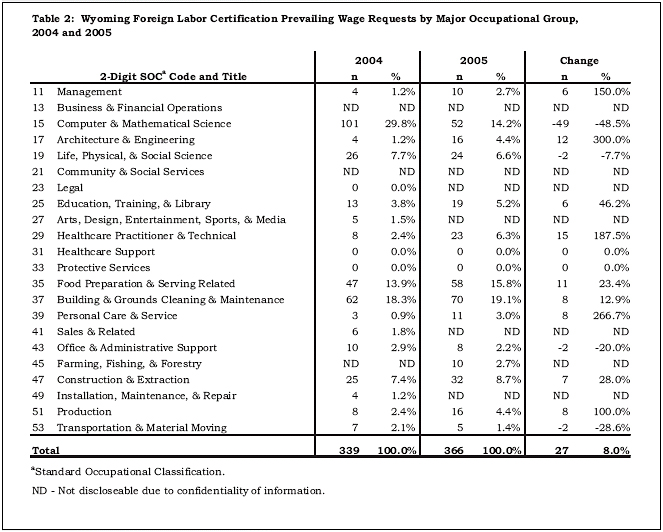© Copyright 2006 by the Wyoming Department of Employment, Research & Planning
Vol. 43 No. 4
To prevent foreign workers from displacing workers from the United States at below-market wages, employers who seek to hire foreign labor must request a prevailing wage determination. The intent of this process is to ensure that the employer pays the prevailing wage or the actual wage paid by the employer to workers with similar skills and qualifications, whichever is higher. From 2004 to 2005, Wyoming prevailing wage requests increased, although the gain was more modest than the increase from 2003 to 2004. By occupation, the largest increase was for Healthcare Practitioner & Technical occupations. This increase might be a sign that healthcare providers are increasingly using foreign workers to fill positions in Wyoming.
Wyoming Foreign Labor Certification prevailing wage requests received by Research & Planning (R&P) increased by a modest 27 requests (8.0%) from 2004 to 2005. This is in contrast to the gains from 2003 to 2004 in which the number of requests rose by 134, a jump of 65.4%. In this article we discuss recent changes to the prevailing wage determination process. We also look at the regions and types of occupations in which increases in 2005 were concentrated.
Background
As part of the U.S. Department of Labor’s Foreign Labor Certification process for incoming foreign workers, a prevailing wage determination from a State Workforce Agency is typically required for a given occupation and geographic location. R&P, in cooperation with the Wyoming Department of Workforce Services’ Jackson office, is the agency that makes wage determinations for Wyoming.
Beginning March 8, 2005, the U.S. Department of Labor, Employment and Training Administration (ETA) instituted changes to prevailing wage determinations regulations (2004). Although several aspects of the wage determination process changed, the modification of the validity period had the greatest impact in Wyoming. In the past, wage determinations were valid for 90 days after the date of response from the agency. States may now set their own validity periods provided that determinations are valid for at least 90 days but not for more than one year. To ease the burden on employers by requiring them to submit fewer wage requests while still providing timely wage data, Wyoming established a 6-month validity period. The change from the 90-day validity period may be partially responsible for slower growth in wage requests.
Prevailing Wage Determinations by Region
Four of the six regions (see map of the state’s regions) saw increases in determination requests of more than 40% (see Table 1). The largest percentage growth was in the Northeast region (90.0%), while the largest numeric increase was in the Central-Southeast region (up 22 requests). Although the percentage growth was smallest in the Southwest region (8.8%), the region accounted for 40.4% of all requests in the state. Teton County accounted for the majority (87.5%) of requests in the Southwest region and 35.5% of all requests in the state.
Only the Cheyenne Metropolitan Statistical Area (MSA) experienced a decline in requests during 2005 (46 fewer requests or -44.7%). A drop in requests for Computer & Mathematical Science occupations drove most of the decrease. In contrast, the Cheyenne MSA had the highest growth from 2003 to 2004, again propelled by Computer & Mathematical Science occupations. The region had just 34 requests in 2003. In 2004, requests grew to 103, a 202.9% increase. Although growth slowed in 2005, the 57 requests for last year were 23 higher than in 2003.
Prevailing Wage Determinations by Occupation
Healthcare Practitioner & Technical occupations saw the highest numeric growth in 2005 (see Table 2) from 8 requests in 2004 to 23 in 2005 (up 187.5%). This increase might be a sign that Wyoming healthcare providers are expanding their searches beyond U.S. borders to help fill positions and counter the nursing shortage (Glover, 2002). Other increases were in Architecture & Engineering (up by 12 requests) and Food Preparation & Serving Related (up 11). Declines were seen in Life, Physical, & Social Science; Office & Administrative Support; and Transportation & Material Moving.
Computer & Mathematical Science occupations had the largest drop in the number of requests from 2004 to 2005 (down 49 requests or 48.5%). In 2004, this occupational group saw the largest increase from 26 requests in 2003 to 101 in 2004 (up 288.5%). Most of the increase for these occupations from 2003 to 2004 occurred in the Cheyenne MSA. Similarly, the majority of the decline from 2004 to 2005 for Computer & Mathematical Science occupations occurred in the Cheyenne MSA. However, the 52 Computer & Mathematical Science requests statewide in 2005 were still double the number of requests in 2003.
Summary
Even though the total number of wage determination requests has increased since 2003, the modest increase in the number of requests in 2005 is in contrast to the sharp growth seen from 2003 to 2004. At least part of the slowing growth is a result of the change in how long wage determinations are valid. Percentage growth was greatest in the Northeast region, while the Cheyenne MSA saw a decline in requests. Healthcare Practitioner & Technical occupation requests grew the most of any occupational group. The occupational group with the largest decline was Computer & Mathematical Science occupations. As the shortage of nurses intensifies, we may see healthcare providers increasingly seek foreign workers.
References
Glover, W. (2002, August). Nursing: Supply shortage or retention issue? Casper, WY: Wyoming Department of Employment, Research & Planning.
U.S. Department of Labor, Employment and Training Administration (2004), Labor Certification for the Permanent Employment of Aliens in the United States; Implementation of New System, 20 C.F.R §§ 655-656.
U.S. Department of Labor, Employment and Training Administration. (2005, May). Prevailing wage determination policy guidance, nonagricultural immigration programs. Retrieved March 2, 2006, from http://ows.doleta.gov/foreign/pdf/Policy_Nonag_Progs.pdf.
Return to text

Table of Contents | Labor Market Information | Wyoming
Job Network | Send Us Mail
Last modified on
by Phil Ellsworth.